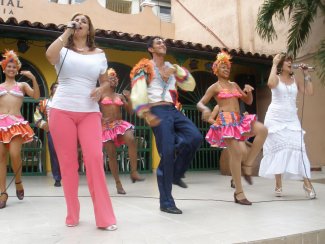 “Camaguey is known as the city of tinajones (huge terracotta or earthenware urns). You will find them everywhere as you walk around town. They are a symbol of our city.” Our guide smiled, then continued, “However, wives, beware! Do not let your husband drink from them! There is a legend that if a man takes a drink offered by a woman from a tinajone, he will fall in love with her and remain in Camaguey the rest of his life.”
“Camaguey is known as the city of tinajones (huge terracotta or earthenware urns). You will find them everywhere as you walk around town. They are a symbol of our city.” Our guide smiled, then continued, “However, wives, beware! Do not let your husband drink from them! There is a legend that if a man takes a drink offered by a woman from a tinajone, he will fall in love with her and remain in Camaguey the rest of his life.”
In the bygone centuries, tinajones were used to collect rain water; but today, they beautify the patios of the city’s colonial homes, parks and roadways. Drawing the attention of residents and visitors alike they are a unique attraction to both the city of Camaguey and the state which carries the same name.
Yet, no matter how interesting these reddish-brown urns are, they are only one of Camaguey’s allurements. This capital of the province of Camaguey – the largest and most prosperous province in Cuba – is located 570 km (350 mi) east of Havana. It sits in the midst the most fertile land in the country, boasting herds of cattle and endless fields of sugarcane.
Camaguey was founded in 1514 on Cuba’s Atlantic coast and prospered from cattle raising and sugar, fostering a local slave plantation economy. This wealth attracted pirate attacks. To ward off these assaults, the city was moved inland and rebuilt on a huge plain with a confusing labyrinth of streets. Nevertheless, this did not save the city. In 1668, the notorious English pirate, Henry Morgan and in 1679, the buccaneer Franois Gramont, both attacked and looted the town.
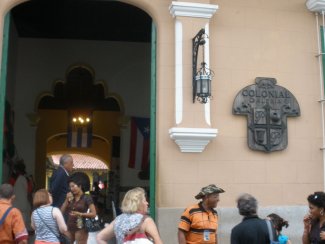 Camaguey, deriving its name from a native village, meaning in the language of the indigenous people, ‘son of a tree’, which once occupied the spot, is the third largest city in Cuba, with 330,000 inhabitants. The most interesting town in the central area of the country, it has been described as a ‘city of squares’ or as the ‘Corinth of the Caribbean’. Its colonial core, a perfect example of the Spanish colonial cities, has been declared a national monument,
Camaguey, deriving its name from a native village, meaning in the language of the indigenous people, ‘son of a tree’, which once occupied the spot, is the third largest city in Cuba, with 330,000 inhabitants. The most interesting town in the central area of the country, it has been described as a ‘city of squares’ or as the ‘Corinth of the Caribbean’. Its colonial core, a perfect example of the Spanish colonial cities, has been declared a national monument,
The heart of town, inherited from its Spanish past, is what makes the city enchanting. Camayuey’s colonial architecture has survived in the shape of huge doors, ironwork decoration, terracotta roofs, and magnificent baroque churches, patios and squares. Its white homes are built around flower and tree decorated hidden patios, surrounded by arches and galleries, edging narrow winding alleyways – the same streets that were planned to thwart the corsairs. With the exception of Havana, Camaguey’s colonial quarter contains more old structures than any other city in Cuba.
Tour officials advise visitors to explore this colonial core by foot – a very logical way to savour the old city. We took their recommendation and soon were walking through a replica of a small 17th century town in the Iberian Peninsula. The pebbled alleys and tiny squares, defusing the aura of medieval Spain, brought to mind the Moorish-like villages of Andalusia.
 Our first stop was the Plaza de los Trabajadores, once the site of circuses and bullfights. Here, we spent sometime examining the edging Casa Ignacio Agramonte, at one time, a huge colonial structure that was the home of the 19th century Cuban hero, Ignacio Agramonte – now housing a historical museum. Agramonte was the most important of the Camagueyans revolutionists who fought the Spaniards and is today fondly remembered by the city’s inhabitants.
Our first stop was the Plaza de los Trabajadores, once the site of circuses and bullfights. Here, we spent sometime examining the edging Casa Ignacio Agramonte, at one time, a huge colonial structure that was the home of the 19th century Cuban hero, Ignacio Agramonte – now housing a historical museum. Agramonte was the most important of the Camagueyans revolutionists who fought the Spaniards and is today fondly remembered by the city’s inhabitants.
Across the Square towers the massive Iglesia de Nuestra Senora de la Merced, built in 1748. The largest church-convent complex in Camaguey, it dominates the Plaza. Under this enormous church are Las Catacumbas (the Catacombs) where, until the 18th century, the deceased of the city were buried.
From the Square, we walked through Camaguey’s main shopping district – a very poor version of the North American shopping centres – to Parque Ignacio Agramonte – the centre of the colonial section and one of the most clean and pleasant spots in town. The park, in the centre of which is a statue of Ignacio Agramonte, is bordered on one side by Camaguey’s Cathedral, Nuestra Seora de la Candelaria; and on another side by the Casa de la Trova, a 19th century artistically-painted Spanish colonial building. In its large patio, nightly musical performances are held.
A 10 minute stroll further on and we were in the restored Plaza San Juan de Dios, the most harmonious and picturesque square in Camaguey. A cobblestone Plaza, it is surrounded by brightly hued single-storey buildings, imbuing with an attractive atmosphere and the charm of the past. The edging San Juan de Dios church and a restored former hospital with an attractive Moorish facade further enhance the area and make it an attractive part of the city to visit.
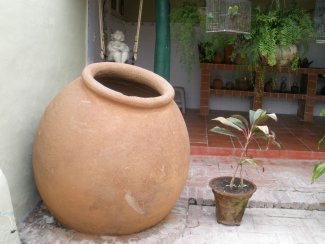 Conversing as we walked along, it seemed that in no time we were in the Mercado Agropecuario El-Ri – a large market where farmers offer the produce of their fields for sale. In the past, this was a forbidden trade, but today it is a flourishing industry. Colourful, clean and full of atmosphere, the market gives the visitor a clue to Cuba’s evolving future.
Conversing as we walked along, it seemed that in no time we were in the Mercado Agropecuario El-Ri – a large market where farmers offer the produce of their fields for sale. In the past, this was a forbidden trade, but today it is a flourishing industry. Colourful, clean and full of atmosphere, the market gives the visitor a clue to Cuba’s evolving future.
Leaving the market’s smiling and friendly vendors, we drove to Barro Casanova, the birthplace of much of Camaguey’s tinajones. Here, the earthenware urns were everywhere. Form tiny tourist souvenirs to huge creations, along with the ovens in which they were baked, the urns filled every inch of the rambling enclosure. After noticing them beautifying all parts of town, it was exciting to see them at their birthplace. For us, it was a fitting end to exploring the ‘city of tinajones’.
If you Go
Facts About the City of Camaguey:
1) About 110 km (68 mi) from Camaguey, is Santa Lucia Beach, 20 km (12 mi) of white sand, where the inhabitants and tourists alike travel to enjoy the charms of nature and the calm sea. Besides the beach the main attraction is a 36 km (22 mi) long reef, the 2nd largest reef in the world – a true mecca for diving and snorkeling enthusiasts.
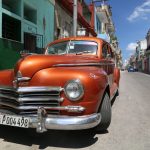

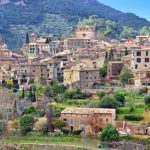

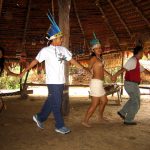
Leave a Reply